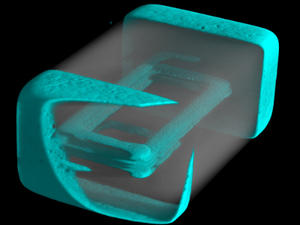Aviation security3D, interactive X-ray to offer dramatic improvement in security scans
The latest X-ray scanners can glean information about the atomic or molecular weight of a substance, and so help distinguish between materials, but the results are crude; the best they can manage is to show metal objects in one color, organic materials in another, and everything else in a third color; a new technique — called kinetic depth effect X-ray imaging, or KDEX — builds up a 3D image of the object which can be rotated and viewed from a wide range of angles

3D X-ray image of coil // Source: phoenix-xray.com
It can be difficult to identify objects from the 2D images generated by X-ray scanners, says Paul Evans, head of the Imaging Science Group at Nottingham Trent University in the United Kingdom. While the latest X-ray scanners can glean information about the atomic or molecular weight of a substance, and so help distinguish between materials, the results are crude. The best they can manage is to show metal objects in one color, organic materials in another, and everything else in a third color.
On an X-ray image, a lump of gorgonzola cheese inside a suitcase “looks identical to TNT,” says Keith Rogers of Cranfield University in Shrivenham, Wiltshire, United Kingdom. Duncan Graham-Rowe writes in New Scientist that with funding from the DHS and the British Home Office, Rogers, Evans, and Anthony Dicken, also at Cranfield, have been developing ways to get around these limitations.
One established approach is to capture X-ray scans that give a sense of depth. 3DX-Ray, a company based in Loughborough, United Kingdom, has been selling stereoscopic X-ray machines for the past decade. To use them, security staff wear polarized spectacles, similar to those used in 3D movie screenings, which help the brain interpret two scans captured from slightly different viewpoints as a single 3D image. Tests by the U.S. Transport Security Administration (TSA) have shown that even the limited depth information available from these scans significantly increases the probability of identifying a suspect object.
Evans says he can extract much more depth information as an object passes through a security scanner. His technique — called kinetic depth effect X-ray imaging, or KDEX — builds up a 3D image of the object which can be rotated and viewed from a wide range of angles.
In a regular airport security scanner, the X-ray source sits beneath the conveyor belt, with a line of detectors above. KDEX uses six or seven sets of these detectors. “We take snapshots of the object at different relative angles,” says Evans, each shot contributing towards a 3D image. Importantly, the technique still requires only one X-ray source — which helps to keep its cost down.
Nick Fox, chief technical
